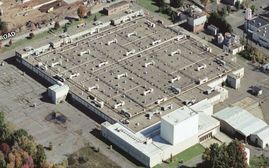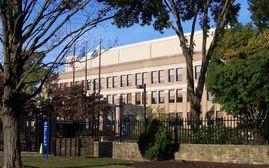
Processing Your Payment
Please do not leave this page until complete. This can take a few moments.
- News
-
Editions
View Digital Editions
Biweekly Issues
- May 13, 2024
- April 29, 2024
- April 15, 2024
- April 1, 2024
- March 18, 2024
- March 4, 2024
- February 19, 2024
- February 5, 2024
- January 22, 2024
- + More
Special Editions
- Lists
- Viewpoints
- HBJ Events
- Business Calendar
- Custom Content
CT companies spend billions on research and development, but some say state should incentivize more of it
 HBJ Photo | Steve Laschever
Mark Maybury, chief technology officer of Stanley Black & Decker, which spent $275.8 million on research and development in 2018, leads the toolmaker’s R&D efforts.
HBJ Photo | Steve Laschever
Mark Maybury, chief technology officer of Stanley Black & Decker, which spent $275.8 million on research and development in 2018, leads the toolmaker’s R&D efforts.
New Britain’s Stanley Black & Decker this year introduced the world’s first artificial intelligence-enabled robotic pill dispenser.
Across the Connecticut River at United Technologies Corp.’s Research Center in East Hartford, employees are tinkering with ways they could use quantum computing to design stronger and lighter metals for aerospace products.
At Bloomfield-based Kaman Corp. R&D workers recently introduced light-weight titanium bearings that cost less than previous models, while Stratford-based Sikorsky is getting closer to greenlighting a fully autonomous helicopter.
Behind all these innovations is a vast array of patents collected by Connecticut-based companies, some of which are the most prolific nationwide when it comes to stockpiling government-backed protections for new discoveries, underscoring their positions as leading innovators.
In fact, about 5,600 patents were filed by Connecticut residents in fiscal 2019, up nearly 5% from a year earlier, according to an annual report issued by the U.S. Patent and Trademark office. Among the largest patent filers and recipients were employees at Stanley and UTC, both of which have large research and development operations in Greater Hartford.
It’s precisely those R&D facilities and jobs that Connecticut has been hard-pressed to keep in-state. For example, pharmaceutical giant Bristol Myers-Squibb moved its research operations out of Wallingford.
And while there’s been some effort to incentivize private-sector R&D to stay here, some say it’s not enough.

Connecticut offers research and development tax credits that reimburse companies up to 6% of their annual R&D spending.
However, due to tight program restrictions, companies have accumulated significant R&D tax credits over the years they can’t cash in.
That’s because the value of some companies’ tax credits exceed their relative corporate income tax liability and there are state-imposed limits on what portion of a tax liability a company can offset with tax credits.
In fiscal year 2018, the latest data available, Connecticut companies carried over $1.8 billion in R&D tax credits because they were unable to use them, according to the Department of Revenue Services.
For years, UConn economist Fred Carstensen has championed allowing companies to use stranded R&D tax credits in exchange for making impactful capital investments.
In response, the state legislature in 2017 passed a “Stranded Tax Credits” program, which allows companies to apply their R&D credits to capital projects, and buy and sell the credits. But the program is capped at $50 million per year, which Carstensen said limits its impact.
“It’s a very limited program, too small to really leverage substantial investment,” said Carstensen, who is also executive director of the Connecticut Center for Economic Analysis (CCEA).
CCEA calculated in 2010 that every $1 billion in stranded credits that companies use would create up to 45,000 jobs. Against that measure, $50 million would create no more than 2,250 jobs.
So far, Wilton computer-chip maker ASML US LLC is the only company that’s taken advantage of the new program, according to the Department of Economic and Community Development’s 2018 annual report, allocating $6 million in R&D credits for a capital project.
The company is expected to create 524 jobs and spend more than $82.91 million on construction and equipment over six years, DECD said.
A DECD spokesman said the stranded credits program hasn’t been around long enough to judge its effectiveness. But one project has shown such a policy can help anchor companies to Connecticut.

In 2014, before the stranded tax credit program was in place, the Malloy administration inked a deal with UTC that allowed the conglomerate to use up to $400 million in unused R&D tax credits on a $60-million refurbishment of its East Hartford Research Center, and a new $180-million engineering facility for jet-engine maker Pratt & Whitney.
As a result of that investment, UTC has no plans to move its R&D activities out of East Hartford, even as the company prepares to relocate its headquarters to Massachusetts, once its $120-billion merger with defense giant Raytheon is complete later this year, said Andreas Roelofs, vice president of research and director of UTC’s Research Center.
“When you see the recent investments that have been made into [the Research Center], as well as into new large facilities, which are tens of millions of dollars, it is extremely important that we’ll continue to be [in East Hartford],” Roelofs said.
And UTC, which spends $4 billion annually on R&D, is putting that investment to good use, Roelofs said. The company was awarded 9,000 patents in the U.S. over the past five years, the company said. In 2018 it received 459 patents in Connecticut.
The Research Center employs about 400 people in highly skilled positions, Roelofs said. About 70% hold a Ph.D. and they all represent a mix of longtime Connecticut residents and people who moved here from around the globe.
UTC’s main R&D focus lies, unsurprisingly, in aerospace, Roelofs said. Research runs the gamut from minor improvements to existing products and technologies, to implementations of new technology.
Among its R&D activities, UTC researchers are currently trying to leverage quantum computing, which could create faster and more accurate simulations of real-world materials, to design lighter and stronger aircraft metals, Roelofs said.

Other innovation
Stanley Black & Decker — which last year was granted 224 U.S. patents, including 104 to Connecticut inventors — spent $275.8 million on R&D in 2018, a 35% increase from two years earlier. The company solidified its R&D operations in 2014 by creating a “special forces” unit that invented the successful FlexVolt cordless battery system that wirelessly charges construction tools, Stanley Chief Technology Officer Mark Maybury said.
Stanley last year opened its Manufactory 4.0 facility in downtown Hartford, where part of its R&D strategy and work takes place.
In addition to the in-house innovation work, Stanley invests in startups through its Stanley Ventures arm, and even guides some companies to maturity through its Stanley+Techstars accelerator, which brings in startups from around the globe to Hartford for a three-month business development bootcamp, Maybury said.
“Part of our strategy is to bring those startups in to brand them, and bring them right into the group,” Maybury said. “We realized that we needed to also begin to better leverage the external ecosystem.”
One company Stanley Ventures invested in, Boston-based Pillo Health, last October launched a robotic pill dispenser called the Pria by Black+Decker Home Care Companion. The product uses a built-in voice activated-assistance system to dispense pills, and communicates with patients’ caregivers. Stanley last year led Pillo’s $11-million fundraising round.
In Bloomfield, Kaman’s approach to R&D focuses on customers’ needs, said Mathew Mormino, Kaman’s vice president of quality and engineering. Before choosing a project to work on, Kaman’s R&D employees consult with customers on what problems they want new products to solve, and “then we’ll develop our products based on what their wish list is,” he said.
Out in Stratford, Sikorsky, a subsidiary of Lockheed Martin Corp., is testing autonomous technology in its S-70 OPV Black Hawk helicopter, which recently flew for the first time, a company spokeswoman said. That brings Sikorsky closer to its goal of building a fully autonomous helicopter by the end of 2020.
For Carstensen, the research and development these companies are doing in Connecticut only underscores the need to unleash more stranded R&D tax credits.
“Thinking small … is just not meaningful,” Carstensen said.
Related Content
Two important points: 1) Properly structured, the use of stranded credits to help fund major capital projects (which help anchor a business in the state) costs the State no net tax revenue. Repeat that: there is no loss of tax revenue. That is because the credits are cashed only after the project is complete and in operation: the tax revenue from income, sales, and business taxes more than offsets the cost of the credits. 2) This use of stranded tax credits, because it incentivizes significant capital investments rather than subsidizing jobs, IS THE MOST POWERFUL DEVELOPMENT TOOL CCEA HAS IDENTIFIED. It has remarkably higher impacts in job creation and they don't fade out. Job subsidies have too often resulted in the jobs leaving when the subsidy ends. But that doesn't happen with this approach because the capital project can't be moved. Beyond the UTC agreement, the initiative that brought JAX genomic labs here has the same virtue: the specialized research building can't be moved. So there is a long-term commitment to Connecticut.

2022 Giving Guide
This special edition informs and connects businesses with nonprofit organizations that are aligned with what they care about. Each nonprofit profile provides a crisp snapshot of the organization’s mission, goals, area of service, giving and volunteer opportunities and board leadership.
Learn more
Subscribe
Hartford Business Journal provides the top coverage of news, trends, data, politics and personalities of the area’s business community. Get the news and information you need from the award-winning writers at HBJ. Don’t miss out - subscribe today.
Subscribe
2024 Book of Lists
Delivering Vital Marketplace Content and Context to Senior Decision Makers Throughout Greater Hartford and the State ... All Year Long!
Read Here-
2022 Giving Guide
This special edition informs and connects businesses with nonprofit organizations that are aligned with what they care about. Each nonprofit profile provides a crisp snapshot of the organization’s mission, goals, area of service, giving and volunteer opportunities and board leadership.
-
Subscribe
Hartford Business Journal provides the top coverage of news, trends, data, politics and personalities of the area’s business community. Get the news and information you need from the award-winning writers at HBJ. Don’t miss out - subscribe today.
-
2024 Book of Lists
Delivering Vital Marketplace Content and Context to Senior Decision Makers Throughout Greater Hartford and the State ... All Year Long!
ABOUT
ADVERTISE
NEW ENGLAND BUSINESS MEDIA SITES
No articles left
Get access now
In order to use this feature, we need some information from you. You can also login or register for a free account.
By clicking submit you are agreeing to our cookie usage and Privacy Policy
Already have an account? Login
Already have an account? Login
Want to create an account? Register
Get access now
In order to use this feature, we need some information from you. You can also login or register for a free account.
By clicking submit you are agreeing to our cookie usage and Privacy Policy
Already have an account? Login
Already have an account? Login
Want to create an account? Register









1 Comments